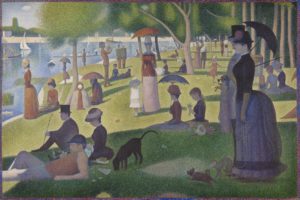
At the end of three inspiring days at the American Heart Association Scientific Sessions (AHA18) in Chicago, I took advantage of my late night return flight to spend the afternoon at the Art Institute of Chicago. The museum has one of the finest collections of impressionist paintings, and I’m a big fan.
Impressionist artists in the mid-1870s in France challenged the artistic traditions of their predecessors. They depicted spontaneity in their paintings by capturing moments of daily life of regular people, focusing on nature, and using bright colors and rapid brush strokes.
The mid-1880s marked the end of Impressionism. Fathers of the movement started challenging the very basic conventions they helped establish. Claude Monet, for example, traveled outside Paris and instead of painting spontaneous moments, his paintings started reflecting thoughtful and deliberate approach with series of paintings of the same subject to reflect all the level of detail. In the last impressionist exhibition in Paris in 1886, Georges Seurat exhibited A Sunday a La Grande Jatte which used pointillism, a scientific technique of painting deliberately distinct from the more intuitive approach of impressionists. It was a challenge to the impressionist movement and marked its end and the start of a post-impressionist era.
The American Heart Association brings breakthrough science in cardiovascular disease to the art of cardiology practice. At the Scientific Sessions every year, you get to see practice-changing clinical trials, which are often the result of at decade or more of pre-clinical and clinical development. Despite that excitement, adoption of new evidence-based therapies remains slow. While economic, drug-specific, and prescriber-specific characteristics play a role, we are sometimes shackled by our habits.
Impressionists revolted on the habits of the past and brought a whole new approach to painting. When they no longer needed it a decade later, they evolved quickly into new techniques. One painting, A Sunday a La Grande Jatte, marked the end of an era.
We can learn from that.
If new anti-diabetic drugs such as GLP-1 receptor agonists and SGLT2 inhibitors are showing cardiovascular benefits, maybe we should take more ownership of diabetes management. If the new cholesterol guidelines recommended lower LDL cut-offs for statin initiation, we should be more proactive about re-evaluating all our clinic patients. And if angiotensin receptor-neprolyhsin inhibitor reduces death in heart failure compared to ACE inhibitor, then we should probably we using it more. There is often a delay in diffusion of scientific sessions research to clinical practice. We should be always conscious that any delay of implementing new scientific findings to patient care is a missed opportunity to save lives.
When AHA was founded in 1925, Dr. Paul Dudley White, one of the co-founders, commented, “We were living in a time of almost unbelievable ignorance about heart disease.” Thankfully nowadays, we have gone so far from that, as we even discuss cutting edge cardiovascular science such as systems-based approaches to drug development, nanotech monitoring in the ICU, and development of an anti-atherosclerosis vaccine.
Like the impressionists, we should continue to challenge the past and present every day, but also free ourselves of habit when necessary, as we strive “to be a relentless force for a world of longer, healthier lives.”